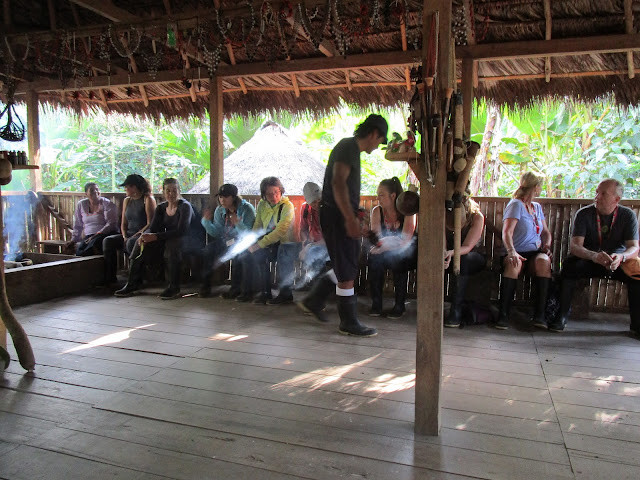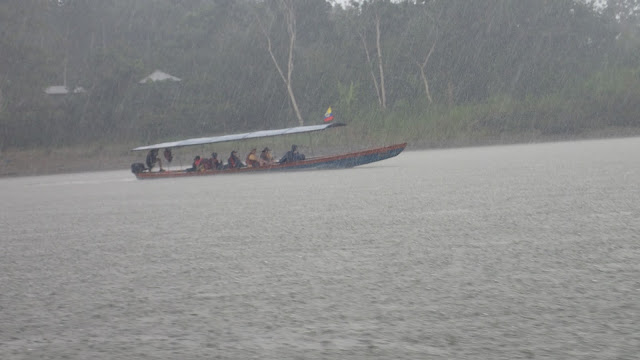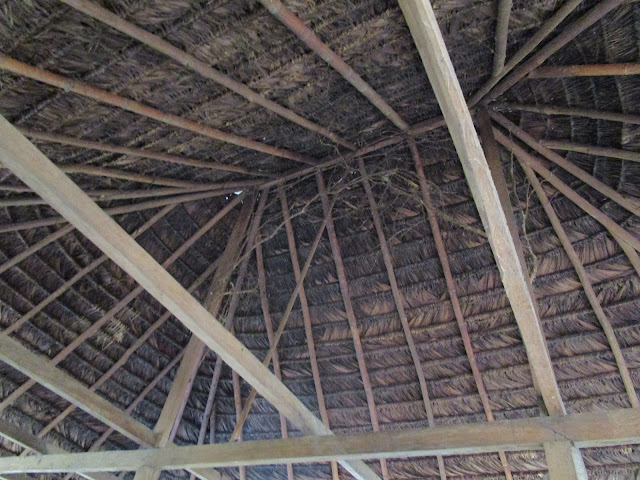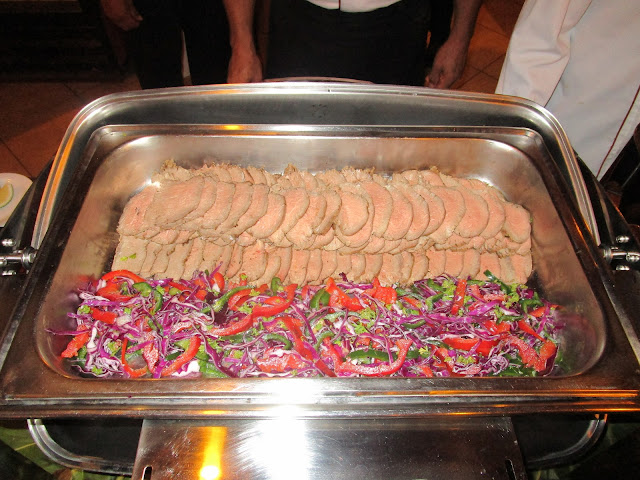Once we were in the canoes, we had a cover, so it helped with the rain a little bit.
Off in the distance we could see a banana canoe going by. This river is used for everything.
This is the little building where the bus dropped us off.
Like I said before, they use this river for everything, even transporting buses.
And then off we went in the rain, up the Napo River.
These canoes aren't very tall. They made me feel like I was sitting right in the water. We could reach out and touch it if we wanted.
There were some local kids out tubing the river in the rain. It looked like they were having so much fun!
After about 15 minutes we could start to see our hotel (La Casa Del Suzio) off in the distance. This would be our home away from home for the next few days.
Then we made our way through the little town up to the hotel on the hill.
We all hung our life jackets over the railing as we climbed the covered stairway to the hotel.
There were lots of stairs.
It didn't take us long to find our first new friend of the rain forest. I've heard that praying mantis are good luck, so I think that we are going to like it here!
We settled into the reception area of the hotel and enjoyed the view for a few minutes while had some tea and waited for our room keys.
We were also introduced to our local guides that would be with us for the next few days and teach us all about the rain forest. The man on the left is Jairo (pronounced Hyro) and on the right is Dario.
Then we were off to check out our rooms at Casa Del Suizo.
The room was great, with everything we could ever need. We had a hammock and a couple of chairs out on the porch. The thing that always makes me sad about these places is that we are so busy that we never get to spend much time in our beautiful rooms.
We all told them what size we normally wear, and they suggested a pair of boots for us. They even had boots big enough for our daughters 6'7" boyfriend. Impressive! Then off to the canoes again. At this point I can't remember if we headed up river or down river, but either way, we were heading to the island of Ahuana where we would meet an indigenous Quechwa woman who would tell us all about living in the Amazon rain forest. Fifty families live on this island, and the Quechwa people have inhabited the rain forests since the 16th century.
As we approached the shore, a woman was washing her hair on the water's edge.
We "parked" the canoes as started making our way up the island. According to Dario, the water in the river is very low because they are just coming into the rainy season. Usually all of the rocks you can see would be under water.
This is a huntaluno, also know as the thorny palm. It probably wasn't too difficult to choose it's name. There is a large beetle larvae that lives in this palm that the Quechwa people eat. Eating this larvae is a cure for asthma and bronchitis.
Dario stopped periodically to show us some of the plants along the way, and to explain to us how they are used by the Quechwa people.
They showed the yucca plant which is a staple for the Quehwa people. When Steve and I saw the plant we realized that it is a tapioca plant.

But mostly, it was just interesting to look around as we made our way through the rain forest.
Before long we reached the village where Carmella, our host, lives.
The houses in this village are elevated for safety from animals and "critters".
The house is made f bamboo, and the pillars and floors are palm. The Quechwa people sleep on the floor on small mats. There is a fire box in the corner which is filled with clay to protect the wood form the fire. Smoke from the fire cures the roof and keeps insects out of the house. All of their food is kept above the fire box to preserve it.

There are thorny branches suspended from the rafters to attract bat. Bats help to keep insects out of the house as well.


Daria carried around a burning termite nest for us. It smells a lot like hominy.
The Quechwa people use gourds as bowls,
A spiny root is used as a grater.
, and a tree branch is used as a hand blender.
Everything that is found in the rain forest is used in some way. These wyusa leaves are used to make an energy tea, but also protect the people from snake bites and mosquitos.
Land snails are good to eat, then the shell is used to signal others in the community.
The yucca is boiled, peeled and smashed. Sweet potato is then grated into water and mixed with the yucca. (Traditionally, this drink was made with saliva instead of sweet potato, but I was happy to hear that they use sweet potato now!). The longer this drink ferments, the more alcohol it will have.
The Chicha smells like yeast and tastes like yeasty, sour beer.

The hardest part about building a house on the island is getting the materials. The whole family and the neighbors will all pitch in to help build a house. It takes 1-3 weeks to build the house once they have all the materials.
They got electricityon the island three years ago, but most of the people still don't use it. When the island got electricity, each family was given a refrigerator and a stove, but most of the families don't use them. They go out and get just the food that they need each day. They might store a small amount of food above the fire, but not usually. The only electric appliance that most of the homes us is a television, and they all LOVE television. Most of the families also have cell phones and satellite TV.
Carmella goes across the river to "town" about twice a month to get meat, and very rarely she might buy some clothes.
When we were finished at Carmella's house, she had some items for sale. We bought some necklaces made from local berries. The orange ones were chickamudro, the white were St. Peter, and the small brown beads were shewangamuyu. After our "shopping trip" we went outside the house where we learned about hunting with blow darts. Blow darts aren't used much any more for actual hunting, but they are still used for recreation. Blow guns are made from ironwood. Two pieces of wood are hallowed out and tied together, then covered in bees wax. The length of the blow gun determines how far it will shoot.
The darts for the blow guns are made of a hard flexible fiber. They sharpen the darts with pirinnah teeth, then kapok fiber (similar to cotton) is added to the end of the dart to help is fly straight. Once we learned how to make a blow gun, we all had a chance to try to use it.
Steve was the first one to hit the monkey with the blow dart. Nice work honey!
Dario showed Steve how to make a dart.
As we got ready to leave, the kids came out to play. They were so cute!
As we made our way back to the beach, the Quechwa boys were out playing soccer. Most of they were barefoot.
As we got back to the rocks of the river bank, the chickens from the house had followed us. Hopefully they know their way home.


Then back to the hotel for a cooking demonstration.
This is the beetle larvae at live in the thorny palms.
It is one of the delicacies we will be trying today.
We got to eat our larvae cooked, but Dario demonstrated with a raw one first.

The rest of the food we got to try from the demonstration.
After our cooking demonstration, we had plenty of time to explore the grounds of the hotel, and enjoy a nice relaxing Christmas Eve with our family and our new found friends.


Even some new found friends that were a bit creepy!
There are so many beautiful and unique plants on the grounds of the hotel.
All of the walkways are covered here because of the rain. It rains a lot in the rain forest!

The indoor/outdoor bar near the dining room is decorated so cute!

The sun set much too soon on the Napo River on the Eve of Christmas, but our night certainly wasn't over.
Another new friend our oldest daughter found in her room.
The hotel put on a Christmas feast fit for kings and queens.
We brought a little Christmas Tree for the kids to decorate before our Christmas Eve dinner.
And the cheer spread quickly throughout the entire dining room.
Before long we had all joined in to the festive dance.
The beautiful Christmas tree in the back ground is made entirely out of plastic bottles. What a great way to recycle!
When the dancing and festivities finally came to an end on the patio, we moved the party to our porch where we continued with the family tradition of reading "Twas the Night Before Christmas" for grandma. It is a tradition that started 25 years ago on our oldest nephew's first Christmas, and has continued every year since then. This year our reading was from the Amazon, which made it even more special.
I honestly can not think of a better place to spend Christmas Eve than with the people we love most (minus a few) in a place that is so beautiful, tranquil and serene.
When you take away the crowds, the hustle and bustle of the big city, the commercialism of what the holiday has become and the gifts (yes, I did say the gifts), it gives us a chance to reflect on what Christmas is really all about.
We are all so thankful to have this unique and incredible opportunity.








































































































































No comments:
Post a Comment